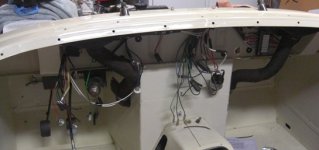Am at the point in resotration where I am thinking about wiring. Have installed alternator with internal voltage regulator. Seems no reason to put original style regulator back in and am thinking about a larger spade fuse block as a starting point. Have run across various threads here and elsewhere on the net and think it would be a good idea to have a few more fused circuits as room allows on the board.
Is there a resource available that would be helpful in matching up my new harness with a larger fuse block and what circuits would benefit from additional fused connections?
I am pretty good with a hammer and wrench but somewhat outside of my element with things that go spark, sizzle and smoke. I have a pile of pages printed out from here and elsewhere but have not run across a direct discussion of dropping the VR and putting in a fuse block.
and smoke. I have a pile of pages printed out from here and elsewhere but have not run across a direct discussion of dropping the VR and putting in a fuse block.
Thanks
Is there a resource available that would be helpful in matching up my new harness with a larger fuse block and what circuits would benefit from additional fused connections?
I am pretty good with a hammer and wrench but somewhat outside of my element with things that go spark, sizzle
 and smoke. I have a pile of pages printed out from here and elsewhere but have not run across a direct discussion of dropping the VR and putting in a fuse block.
and smoke. I have a pile of pages printed out from here and elsewhere but have not run across a direct discussion of dropping the VR and putting in a fuse block.Thanks

 Hi Guest!
Hi Guest!

 smilie in place of the real @
smilie in place of the real @
 Pretty Please - add it to our Events forum(s) and add to the calendar! >>
Pretty Please - add it to our Events forum(s) and add to the calendar! >> 

